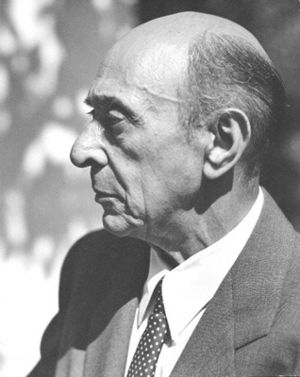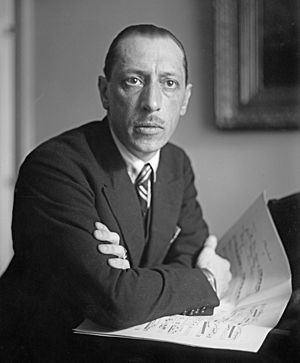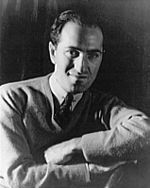20th-century classical music facts for kids
20th-century classical music is a type of art music created between the years 1901 and 2000. During this time, music styles changed a lot, more than ever before. So, there wasn't just one main style. Ideas like modernism, impressionism, and post-romanticism started before 1900. But they grew and changed a lot in the 20th century, going beyond older styles.
New styles like neoclassicism and expressionism mostly appeared after 1900. Later in the century, minimalism began. This style marked a shift from modern to postmodern music. Other new ideas developed too, like chance music, music without a main key (atonality), serialism (using a specific order of notes), musique concrète (music made from recorded sounds), electronic music, and concept music. Also, Jazz and different kinds of folk music became very important for many composers.
Contents
History of 20th-Century Classical Music
At the start of the 20th century, music often sounded like late Romantic music. Composers such as Gustav Mahler, Richard Strauss, and Jean Sibelius were pushing the limits of post-Romantic symphonies. At the same time, the Impressionist style was growing in France. Claude Debussy led this movement. He didn't like the term "Impressionism" himself. Maurice Ravel's music is also often called impressionist. But he explored many styles beyond it.
Many composers reacted to the Romantic and Impressionist styles. They started exploring very different paths. A big change in music happened when composers began to break away from traditional tonality. This means music that doesn't have a clear "home key." This happened in many different ways in the early 1900s. It led to a huge variety of styles and techniques.
In Vienna, Arnold Schoenberg developed atonality. This came from the expressionism movement. Later, he created the twelve-tone technique. This method uses all 12 notes of the musical scale in a specific order. His students, Alban Berg and Anton Webern, developed it further. Other composers, like Pierre Boulez, also used and expanded this technique. Even Igor Stravinsky used twelve-tone technique in his later works.
After World War I, many composers looked to the past for ideas. They created music that used elements like forms, harmonies, and melodies from older music. This style was called neoclassicism. Famous composers like Igor Stravinsky (with Pulcinella), Sergei Prokofiev (with Classical Symphony), and Maurice Ravel (with Le Tombeau de Couperin) wrote neoclassical pieces.
Italian composers like Francesco Balilla Pratella and Luigi Russolo created musical Futurism. This style often tried to use everyday sounds in music. It aimed to sound "futuristic." "Machine Music" by George Antheil and Alexander Mosolov grew from this idea. Composers also explored microtones. These are notes smaller than the usual half-steps on a piano. Voices and string instruments can make them easily. But pianos and organs cannot without special changes.
In the 1940s and 1950s, composers like Pierre Schaeffer started using technology in music. This was called musique concrète. Later, the term electroacoustic music was used for all music involving magnetic tape, computers, synthesizers, and other electronic tools. Live electronic music uses electronic sounds during a performance. John Cage's Cartridge Music is an early example. Spectral music uses sound analysis to create music. Many famous composers wrote electroacoustic music.
From the 1950s, John Cage added elements of chance to his music. This meant the outcome was not always planned. Process music explores a specific musical process that is clear in the piece. The term experimental music was used by Cage for works with unexpected results. It also describes music that pushes boundaries or mixes different styles.
Important cultural trends influenced music during this time. Igor Stravinsky and Sergei Prokofiev were interested in primitivism early in their careers. This style used simple, raw, or tribal sounds. Dmitri Shostakovich and other Russian composers had to work under socialist realism. This was a style approved by the government. Other composers, like Benjamin Britten, explored political themes in their works. Nationalism was also important. American culture influenced a unique American classical music style. Composers like Charles Ives and George Gershwin used American sounds. Folk music and jazz also influenced many composers.
In the last part of the century, mixing different styles became common. This is called eclecticism and polystylism. Minimalism, New Complexity, and New Simplicity also became important.
Styles of 20th-Century Classical Music
Romantic Style
At the end of the 19th century, the Romantic style began to change. It split into different paths, like Impressionism and Post-romanticism. In the 20th century, new styles appeared. Some were a reaction against older music, while others built on it. Both kinds of styles existed together for a long time.
In the early 1900s, many composers continued to write music that extended 19th-century Romantic ideas. They still used traditional groups of instruments, like the orchestra and string quartet. Old forms like the symphony and concerto were also still used. Composers like Gustav Mahler and Jean Sibelius took these traditional forms and gave them new life.
Neoclassicism
Neoclassicism was a style popular between the two world wars. It aimed to bring back the clear forms and themes of music from the 17th and 18th centuries. Composers wanted to move away from the overly dramatic and formless music of late Romanticism. These composers often used new ways of writing music, like extended tonality or atonality. This made their music sound like a modern twist on older styles.
Famous examples include Prokofiev's Classical Symphony and Stravinsky's Pulcinella. Other composers like Paul Hindemith and Manuel de Falla also used this style. Maurice Ravel's Le Tombeau de Couperin is sometimes seen as neo-baroque, which is similar.
Jazz-Influenced Classical Music
Many composers mixed elements of jazz with classical music styles. Here are some notable examples:
- Malcolm Arnold
- Leonard Bernstein
- Marc Blitzstein
- Aaron Copland
- George Gershwin
- Nikolai Kapustin
- Constant Lambert
- Darius Milhaud
- Maurice Ravel
- Gunther Schuller
- John Serry Sr.
- Dmitri Shostakovich
- Karlheinz Stockhausen
- Igor Stravinsky
Movements in 20th-Century Music
Impressionism
Impressionism began in France. It was a reaction against the strong emotions and grand themes of German Romanticism. Claude Debussy led this movement. He believed art should be a sensory experience, not just intellectual. He encouraged French composers to look back at 18th-century French music. This music aimed to charm and entertain.
Other composers linked to impressionism include Maurice Ravel, Albert Roussel, and Manuel de Falla. Many French composers continued this style into the 1920s and beyond. Composers from other cultures and jazz musicians were also influenced by impressionist music.
Modernism
Futurism
Futurism was an art movement started in Italy in 1909. It quickly became popular in Russia. In 1913, the painter Luigi Russolo wrote a paper called The Art of Noises. He suggested using all kinds of noises in music. Besides Russolo, composers like Franco Casavola and Mikhail Matyushin were part of this movement.
Few futurist works are played today. But Futurism had a huge impact on 20th-century music. Composers like Sergei Prokofiev, Igor Stravinsky, and Edgard Varèse were influenced by it. Later 20th-century music used ideas from Futurism. These include the prepared piano (a piano with objects placed on its strings), serialism, and minimalism.
Free Dissonance and Experimentalism
In the early 20th century, Charles Ives combined American and European music. He also mixed everyday sounds with church music. He used new techniques in rhythm, harmony, and form. His methods included polytonality (using multiple keys at once) and quarter tones (notes between the usual ones). Edgard Varèse wrote very dissonant pieces. He used unusual sounds and new instruments. He was a pioneer in electronic music.
Expressionism
By the late 1920s, expressionism was being replaced by other styles. These included the more objective Neue Sachlichkeit and neoclassicism. After World War II, expressionist music gained new interest. This was because the Nazis had banned it. Composers like Hans Werner Henze and Pierre Boulez used expressionist ideas again.
Postmodern Music
Postmodernism is a reaction to modernism. It can also be seen as a response to a big change in how society felt. Some believe postmodernism began when people became more pessimistic, around 1930.
John Cage is a very important figure in 20th-century music. He is seen as both a modernist and a postmodernist. His influence grew steadily. He often used elements of chance in his music. For example, Imaginary Landscape No. 4 uses 12 radio receivers. His Sonatas and Interludes (1946–48) are for a prepared piano. This is a normal piano whose sound is changed by placing objects inside it. Today, postmodernism includes composers who react against the very experimental styles of the late 20th century.
Minimalism
In the later 20th century, composers like La Monte Young, Philip Glass, and Steve Reich began to explore minimalism. In this style, the music is very simple. It often uses repetition. An early example is Terry Riley's In C (1964). In this piece, musicians choose short phrases from a list. They play them many times, while the note C repeats in the background.
Steve Reich's Piano Phase (1967) and Drumming (1970–71) use a technique called phasing. In phasing, two players start playing the same phrase. One plays slightly faster than the other. This makes them go "out of phase" until they come back together. Reich said Drumming was his last use of this technique. It also used new ideas like slowly changing beats for rests.
Philip Glass's 1 + 1 (1968) uses an additive process. Short phrases slowly get longer. La Monte Young's Compositions 1960 uses very long notes and loud volumes. It also includes non-musical ideas like "draw a straight line and follow it." Some believe minimalism was a reaction to other complex styles.
Techniques in 20th-Century Music
Atonality and Twelve-Tone Technique
Arnold Schoenberg is one of the most important composers of the 20th century. His early works sounded like late Romantic music. But he later developed atonality. This means music without a main key. He used this in pieces like Drei Klavierstücke (1909).
In 1921, he created the twelve-tone technique. This is a way of composing using all 12 notes of the musical scale in a specific order. His first big work using this was the Wind Quintet (1923–24). Later, he wrote the Violin Concerto (1936) using this technique. Sometimes, he returned to a more tonal style.
Schoenberg taught Anton Webern and Alban Berg. These three are known as the Second Viennese School. (Haydn, Mozart, and Beethoven are the First Viennese School). Webern used the twelve-tone method very strictly. Berg, like Schoenberg, mixed twelve-tone technique with a late-Romantic style. He wrote two major operas, Wozzeck and Lulu.
Electronic Music
The ability to record sounds changed music. All sounds could now be used as musical material. Electronic music refers to art music developed in the 1950s. The spread of magnetic tape allowed composers to record and change sounds. All electronic music is heard through loudspeakers.
There are two main types. Acousmatic music exists only as a recording. It is meant for listening through speakers. Live electronic music uses electronic devices to create or change sounds during a performance. This can involve musicians using voices or instruments. From 1957, computers became very important in this field. When the sounds came from the everyday world, it was called musique concrète. When sounds were made by electronic generators, it was called electronic music.
After the 1950s, "electronic music" was used for both types. Sometimes, electronic music was mixed with traditional instruments. Edgard Varèse's Déserts (1954) and Mario Davidovsky's Synchronisms are good examples.
Other Notable 20th-Century Composers
Some important 20th-century composers don't fit neatly into one specific style. Here are some of them, along with others mentioned earlier:
- Samuel Adler
- Louis Andriessen
- Béla Bartók
- Havergal Brian
- Elliott Carter
- Carlos Chávez
- Edward Elgar
- George Enescu
- Gabriel Fauré
- Morton Feldman
- Brian Ferneyhough
- Alberto Ginastera
- Henryk Górecki
- Sofia Gubaidulina
- Alan Hovhaness
- György Ligeti
- Witold Lutosławski
- Bruno Maderna
- Bohuslav Martinů
- Carl Nielsen
- Krzysztof Penderecki
- Francis Poulenc
- Giacomo Puccini
- Sergei Rachmaninoff
- Alfred Schnittke
- Kaikhosru Shapurji Sorabji
- Patric Standford
- Mikis Theodorakis
- Michael Tippett
- Joan Tower
- Ralph Vaughan Williams
- Heitor Villa-Lobos
- William Walton
- Judith Weir
- Iannis Xenakis
See also
 In Spanish: Música clásica del siglo XX para niños
In Spanish: Música clásica del siglo XX para niños







